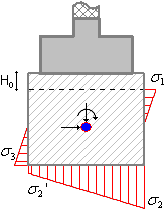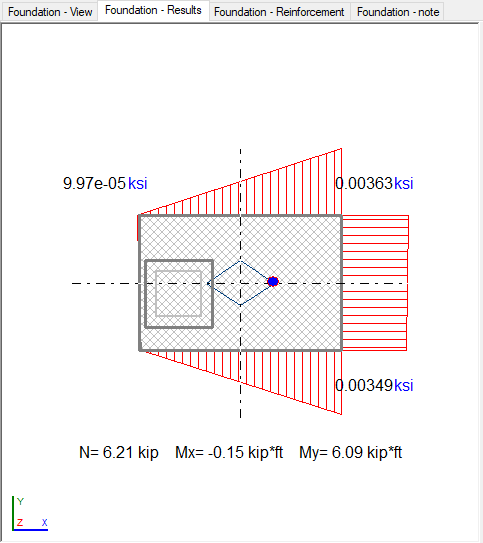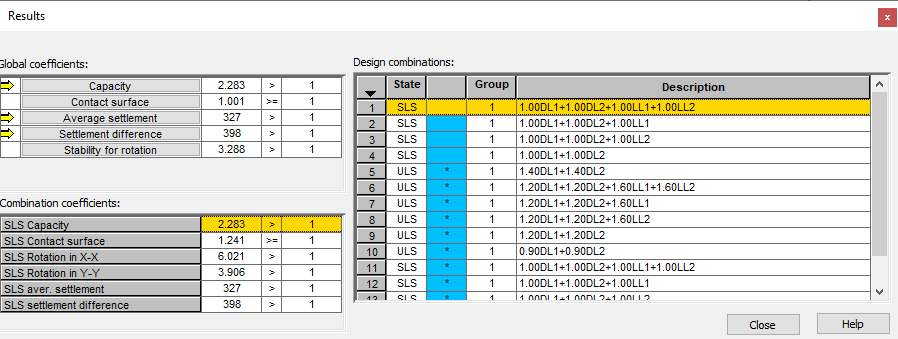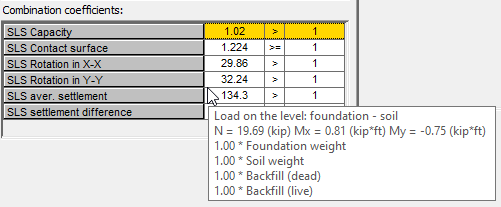To obtain calculation results for defined spread or continuous footings:
- Select Results > Diagrams.
- Click
 (Calculation Start ).
(Calculation Start ). - Select the Foundations - results layout.
Footing design includes:
- Checking the pressure under the footing
- Checking the stability for sliding
- Checking the stability for rotation
- Checking the foundation uplift
- Taking account of seismic dispositions (foundation check for sliding and uplift)
- Checking the punching/shear
- Setting the appropriate reinforcement in the footing and in the column-footing connection.
- Spacing of the set reinforcement in the footing and in the footing -column connection.
- Setting total amounts of required concrete, form-work and reinforcement.
See also:
General rules of the foundation design (considering the requirements of the available codes) .
The result layout presents stresses on sides and under the block foundation. Lean concrete / Block foundation should be selected to display these results.
The following stresses will be evaluated for the block foundation:
σ1 - Upper lateral stress
σ3 - Lower lateral stress
σ 2 - Stress under the block foundation on the right side
σ2 - Stress under the block foundation on the left side.
H 0 - Height of the soil measured from the top of the block foundation for which stress will not be calculated (it is not taken into account in calculations).

Checks during spread footing calculations on lean concrete / block foundation include:
- Spread footing: capacity, stability for overturning.
- The contact between the spread footing and lean concrete/block foundation: uplift (contact surface)
- Lean concrete/block foundation: capacity for X / Y, lateral capacity for X / Y.
If dowel bars are generated between the spread footing and lean concrete / block foundation, the sliding condition is not checked.
Once spread or continuous footing calculations have begun, the Foundations - results layout is enabled by default. The layout includes the graphic viewer displaying the spread /continuous footing (with obtained results, the results for the soil, and the Foundation - results dialog.
Select Results > Calculation Note to view the calculations textually.
When designing a footing, the following values may be presented:
- Footing projection onto the XY plane with pier positioning (top view of the .footing).
- Diagram of stresses in the soil under the footing with values in footing corners.
- Core
- Contour taken into consideration for punching/shear (marked with green) during calculation.
For distribution of stresses under the foundation, values of forces and moments acting directly at points of foundation-soil contact are displayed.
When designing a continuous footing, the cross-section of the foundation and the diagram of stresses in the soil underneath are presented.

Calculation results in numeric form are presented in the Foundation- results dialog.

External load combinations (external loads are loads applied to the pier or to the top surface of the foundation) for which the designed spread or continuous footing was verified are presented in the Design Combinations field. The following information is given in this field: combination type (ULS, SLS), load group, and a number of a load multiplied by the appropriate coefficient. Combinations marked with an asterisk refer to combinations used for RC calculations (reinforcement, punching, etc.); combinations without an asterisk refer to combinations used for soil calculations (soil capacity, stability for overturning, and so on). Values of forces and moments including the self-weight of the foundation display under the drawing of the stress distribution in the Foundations - Results dialog.
Safety factors for the active load combination (highlighted in the Design Combination field) are presented in the Combination Coefficients field. All verified combinations for the active design combination are given in this field. The description contains: the combination type for which the verification was carried out and the real value of the coefficient value in relation to the limiting value. After you click one of the coefficients, the drawing of stress distribution displays the solution for that coefficient.
If the coefficient value is expressed with the INF symbol (infinity), this condition does not occur for the designed spread or continuous footing. The applied loads do not cause a rotation of the spread or continuous footing.
Six buttons are found in the Global coefficients field: Capacity, Contact surface, Stability for sliding, Stability for rotation, Average settlement and Punching/Shear. The most unfavorable coefficients for the appropriate types of the spread / continuous footing verification are presented in the fields to the right. Clicking on the selected button results in highlighting the combination for which the presented safety factor was obtained in the Design Combination field.
If any of the conditions of spread / continuous footing verification are not met, they are presented in red. If any of the spread footing/continuous footing verification types were turned off (the Geotechnical Options dialog), the field in which the global safety factor for rotation is presented is disabled. This safety factor will be calculated and presented in the appropriate field but during calculations, the user will not be warned about the possible unfulfilled stability condition of the spread footing/continuous footing for rotation.

